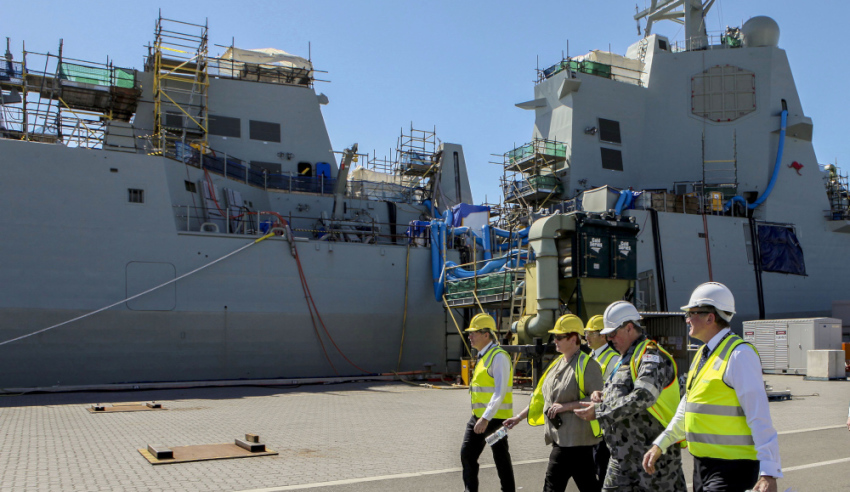Australia’s $90 billion naval shipbuilding program has been described as a major step-change in the way the nation conducts not only naval shipbuilding, but establishes industry policy in the era of industry 4.0 – however, do time frames, albeit relatively short ones, between construction of major warships and submarines present a series of risks to program cost, delivery and naval capability?
To continue reading the rest of this article, please log in.
Create free account to get unlimited news articles and more!
As a maritime nation, Australia is dependent on unlimited access to the ocean – as the regional paradigm changes, there is greater strain on the Navy to protect the national interests and naval assets like the Canberra Class amphibious warfare ships, combined with concerns about the continuity of Australia's sovereign naval shipbuilding industry in between major programs.
Now, for the first time in the nation's history, Australia's prosperity, security and way of life is intrinsically linked to the ambition, stability and direction of its Indo-Pacific neighbours. Guaranteeing this requires the nation to find a balance between the expeditionary and interventionist focused 'Forward Defence' and the continental defence focused 'Defence of Australia' doctrines to counter the high- and low-intensity threats to the nation's security and interests.
Australia's focus on the Indo-Pacific region makes a great deal of sense, particularly given the positioning of key regional economic and strategic partners across what has been referred to as the 'Arc of Instability', which plays host to a range of traditional state and asymmetric economic and political challenges. However, the growth of China and India and smaller nations surrounding them, combined with the importance of the Indo-Pacific as a pillar of the national, regional and global economy, now requires renewed Australian focus.
Woth the Defence Industrial Capability Plan and the $95 billion Naval Shipbuilding Plan set out how the government is delivering on the commitment to build a strong, sustainable and innovative Australian naval shipbuilding industry.
The NSP states, "The goal of the Naval Shipbuilding Plan is to ensure that the regeneration of the Royal Australian Navy over the coming decades will ensure both a cost-effective solution for the government provide Navy the assured capability to fight and win. The National Naval Shipbuilding Office has been established to implement the Naval Shipbuilding Plan."
With $90 billion worth of naval shipbuilding programs, the Royal Australian Navy and naval shipbuilding industry would appear to be in an enviable position, however, the long lead time on key programs and ramp-up in delivery poses challenges for industry – in particular, the $50 billion SEA 1000 Attack Class submarine and $35 billion Hunter Class programs face the potential for delay as a result of growing windows between the construction periods of major surface warships and submarines in Australia.
Further complicating matters is the thinly defined concepts of 'sovereign' and 'sustainable' as they relate to Australia's naval shipbuilding leave many unanswered questions, as does the ever-present spectre of the infamous 'valleys of death' between major projects that severely impact the capability, sustainability and cost of delivering major naval platforms.
A short time between drinks still has an impact
The complexity of contemporary naval platforms, like landing helicopter dock ships (LHD), guided-missile destroyers, frigates and submarines, equates to long design, capability definition, lead materials and workforce development prior to the commencement of construction. This is particularly evident in the case of the relatively short period between the delivery of the final Anzac Class frigate and work beginning on major block components for the Hobart Class guided-missile destroyers in the mid-2000s.
The relatively short delay between the delivery of the final Anzac Class vessel and construction commencing on HMAS Hobart revealed the startling rate at which naval shipbuilding skills and project management capabilities atrophy in the modern naval shipbuilding environment, raising a poignant question: if Australia is serious about developing its naval shipbuilding industry, should continuous shipbuilding actually mean continuous shipbuilding?
Looking towards the delivery of the HMAS Hunter and HMAS Attack, the questions come at a timely junction for Australia's defence industry and political leaders as they seek to avoid repeating the mistakes of the past and dooming another generation of major surface and submarine acquisition to the same fate as the much-maligned, yet highly capable Collins and Hobart Class vessels, both of which were frequently on the projects of concern list.
So, how does Australia avoid repeating these issues, project delays and cost overruns on projects that are incredibly politically sensitive, support capability delivery to the warfighter, while maximising value for money for the Australian taxpayer and supporting the development of Australia's sovereign naval shipbuilding industry?
Your thoughts
Developing and implementing a cohesive, innovative and long-term vision for Australia's sovereign defence industry capability and the naval shipbuilding industry as a whole can also serve as the basis for developing, and in some cases redeveloping, a robust, advanced manufacturing economy taking advantage of Australia's unrivalled resource wealth – supporting the broader national security and interests in the Indo-Pacific.
So, let's ask the question, what is the long-term goal for Australia's naval shipbuilding industry and capability, what does it look like and what does it involve? How can Australian industry work collaboratively with government beyond the 2030s? Should continuous actually mean continuous research, design and development, and construction? Let us know your thoughts and ideas supporting the next stages of development for Australia's sovereign defence capability in the comments section below, or get in touch with

 Login
Login







